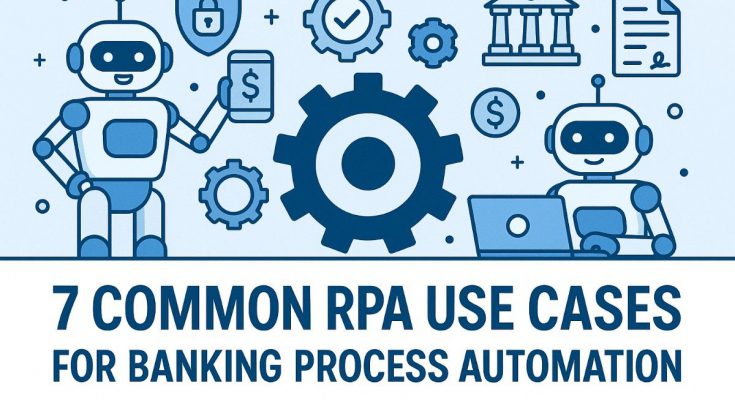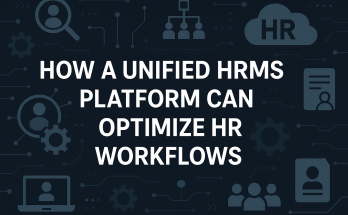Banking is a workflow-driven business of checks and balances. While digital channels have transformed the way customers engage with banks, many internal banking workflows continue to depend on manual interventions and legacy systems. This imbalance slows down operations and increases the risk of delays and non-compliance. RPA in banking process automation bridges this gap by automating high-volume, rules-driven tasks without the need for large-scale system overhauls.
By implementing RPA, banks can significantly cut down operational costs and reduce errors, while maintaining strict regulatory compliance. This can be achieved without replacing core systems, as RPA works alongside existing infrastructure. Research indicates that close to 60% of banking processes are suitable for automation, presenting a strong case for banks to leverage RPA for improved efficiency and customer satisfaction.
Common Banking Challenges RPA can Address
Banking processes are built on rules, structure, and repetition. Every day, financial institutions manage high volumes of tasks, from data validation to compliance checks, across departments. Many of these workflows are still managed manually or through legacy systems that were never designed for today’s pace of operations.
This results in operational delays, increased errors, and higher costs, especially when compliance requirements and customer expectations are rising. RPA offers a direct response to these challenges. It helps automate routine and structured activities by working across applications without changing existing systems.
Here is how RPA addresses some of the core operational challenges in banking:
Banking Workflows Before and After RPA Integration
Before RPA
After RPA
Robotic Process Automation (RPA) enables banks to optimise their operations by working in harmony with existing systems. This synergy leads to significant improvements in data accuracy, substantial reductions in processing time, and greater cost control, all while bypassing the need for costly and complex IT overhauls.
RPA Use Cases in Banking Process Automation
Across the banking sector, there is a growing shift toward automation for handling routine tasks that were once entirely manual. From updating customer records to processing reports, these repetitive operations can now be completed more quickly and accurately using RPA. This shift is not just about saving time—it is about reshaping how banks operate in a digital economy. With RPA, institutions can streamline workflows, improve consistency, and focus their resources where they create the most impact.
To illustrate RPA’s value in banking, here are 7 high-impact use cases and respective functions where automation can drive measurable improvement.
1. Customer Onboarding & KYC Automation
Customer onboarding is one of the most document-heavy and compliance-sensitive processes in banking. Traditional methods are not only time-consuming but also prone to manual errors, leading to delays, dissatisfied customers, and regulatory risks.
| S.No. | Banking processes | How RPA automates | Tangible outcomes |
|---|---|---|---|
| 1. | Automated ID & Document Verification OCR/NLP for Aadhaar, PAN, Passport validation with API integration |
Bots extract, classify, and verify IDs instantly while interfacing with government APIs for real-time authentication. | Faster onboarding, minimal manual errors, higher KYC success rate |
| 2. | AML & Background Screening Screening against global watchlists & credit bureaus |
RPA bots auto-fetch and review data from multiple sources to flag suspicious or high-risk profiles in real time. | Faster red-flagging, reduced due diligence workload, enhanced compliance |
| 3. | Form Auto-Fill & Validation Pre-filling based on CRM or scanned inputs |
Auto-completes multiple KYC forms with pre-validated CRM data, reducing input errors and resubmissions. | Improved data accuracy, faster form completion, lower error rates |
| 4. | Customer Risk Profiling AI-supported RPA classification |
Works with machine learning models to segment customers into defined risk levels and recommend action paths. | Faster compliance decisions, more intelligent onboarding, improved segmentation |
| 5. | Real-Time Core System Syncing Auto-updating CRM and Core Banking Systems |
Once verification is complete, bots push structured data to all relevant backend systems instantly. | Zero duplication, fewer manual steps, real-time record updates |
2. Loan Processing and Credit Assessment
Loan processing is a high-volume, time-sensitive function in banking, traditionally bogged down by paperwork, siloed data, and slow credit decision-making. Robotic Process Automation (RPA) can transform this workflow by accelerating and standardising every stage, from data intake to underwriting.
| S.No. | Banking processes | How RPA automates | Tangible outcomes |
|---|---|---|---|
| 1. | Automated Data Extraction from Loan Applications Multi-format capture and validation, cross-verification with CRM & KYC |
Bots capture and validate applicant details from PDFs, scanned forms, and online submissions, cross-checking data with CRM records and external databases. | Reduces manual entry errors, speeds validation by up to 50%, improving processing efficiency |
| 2. | Credit Bureau Report Integration Automated credit score retrieval and delinquency checks |
RPA bots access bureau portals, extract credit histories, and flag risks automatically for quick review. | Faster risk assessment, reduced manual verification, better credit decision accuracy |
| 3. | Bank Statement Analysis & Financial Profiling Parsing transactional data for credit scoring inputs |
Bots transform unstructured statements into actionable insights, identifying income patterns and financial risks quickly. | Enhanced credit scoring accuracy, early red-flag detection, reduced default risk |
| 4. | Trigger-Based Risk Assessment Rule-based credit risk flagging and prioritisation |
Automated triggers apply credit risk models, escalating high-risk cases for human review or fast-tracking low-risk loans. | Improved underwriting precision, reduced turnaround for risky cases, consistent rule application |
| 5. | Decision Routing and Workflow Management Smart routing by loan type, amount, and risk category |
Intelligent routing directs applications to appropriate underwriters with vetted data, streamlining the decision workflow. | Reduces bottlenecks, accelerates approval cycles, improved decision accuracy |
| 6. | Document Checklist Automation Automated validation of submitted loan documents |
Bots verify uploaded documents against product checklists, notifying applicants or relationship managers about missing or invalid files. | Lowers rework rates, ensures document completeness, speeds up loan processing |
3. Regulatory Compliance and Reporting
In today’s highly regulated banking environment, maintaining compliance isn’t optional—it’s mission-critical. However, compliance processes involve repetitive, high-frequency tasks that are both time-consuming and prone to human error. This is where RPA emerges as a compliance enabler, ensuring precision, speed, and audit readiness.
| S.No. | Banking processes | How RPA automates | Tangible outcomes |
|---|---|---|---|
| 1. | Automated AML Transaction Monitoring High-volume transaction anomaly detection and escalation |
Bots monitor thousands of transactions daily to flag potential money laundering cases and auto-escalate suspicious activity for review. | Early detection accelerates investigations, reduces manual review burden, and increases screening coverage. |
| 2. | Suspicious Activity Detection and Alerts Rule-based transaction cross-checking and alert generation |
RPA bots apply risk rules on transactions and generate detailed alerts ready for compliance action or escalation. | Improved alert accuracy reduces false positives and enables swift compliance responses. |
| 3. | Regulatory Report Generation Consolidation of data for standardised compliance reporting |
Automatically aggregates data from multiple systems to produce accurate, timely reports like CTR, STR, FATCA, and CRS. | Accelerates report generation by up to 90%, minimises submission errors, and ensures regulatory consistency. |
| 4. | Real-Time Compliance Updates Agile bot rule updates for evolving regulations |
Bot logic can be quickly modified to align with new rules, avoiding costly workflow redesigns and compliance lapses. | Ensures continuous compliance, reduces adaptation time, and minimises operational disruption. |
| 5. | Audit Trail and Documentation Logs Comprehensive, tamper-proof logs of automated actions |
All bot activities are logged with timestamps, creating full audit trails that simplify internal reviews and regulatory inspections. | Boosts audit readiness, reduces compliance risk, and ensures transparent documentation. |
| 6. | Reconciliation Automation Automated ledger and regulatory data matching |
Bots reconcile internal records with regulatory filings, proactively identifying mismatches to prevent penalties. | Enhances data integrity, avoids costly compliance breaches, and streamlines reconciliation processes. |
4. Account Opening and Closure Automation
From opening new savings accounts to closing dormant ones, the account lifecycle includes multiple checkpoints, validations, and backend dependencies. Traditionally, this process consumes back-office hours and is vulnerable to delays or customer dissatisfaction. RPA transforms this workflow into a frictionless, rules-based, and audit-ready operation.
| S.No. | Banking processes | How RPA automates | Tangible outcomes |
|---|---|---|---|
| 1. | Auto-Validation of Onboarding Documents Duplication, completeness, and compliance checks |
Bots validate forms, IDs, and eligibility automatically, ensuring regulatory alignment and error-free submissions. | Accelerates onboarding, reduces manual errors, and strengthens regulatory compliance. |
| 2. | Trigger-Based Workflow for Approvals Rule-driven multi-department approval automation |
Automatically initiates approvals post-validation, with real-time notifications via SMS, email, or app. | Streamlines approval cycles and keeps stakeholders informed at every step. |
| 3. | Core Banking System Synchronisation Auto-updates CBS, CRM, and digital channels |
Ensures backend systems reflect account changes instantly, avoiding delays and mismatches. | Boosts data accuracy and operational efficiency across platforms. |
| 4. | Dormant Account Identification and Alerts Policy-driven inactivity monitoring and notifications |
Monitors account inactivity, sends alerts or triggers soft closure workflows per policy. | Eliminates dormant account backlogs and supports proactive risk management. |
| 5. | Automated Closure Processing Checks, stakeholder notification, and backend reconciliation |
Completes pending checks, notifies all parties, and finalises closure post-approval with confirmation generation. | Ensures error-free, transparent closure process with audit-ready confirmation. |
| 6. | Real-Time Status Reporting Operational dashboards for tracking and exception management |
Dashboards provide branch managers and compliance teams with up-to-date account and closure status insights. | Enables data-driven decisions and faster exception resolution. |
5. Invoice Processing and Reconciliation
While often seen as a back-office task, invoice handling plays a vital role in banking operations, especially for vendor payments, inter-branch billing, and customer fee reconciliations. Manual handling not only delays settlements but also increases the risk of financial leakage. RPA brings speed, accuracy, and accountability to the entire invoice lifecycle.
| S.No. | Banking processes | How RPA automates | Tangible outcomes |
|---|---|---|---|
| 1. | Automated Invoice Retrieval & Data Entry Extracts and standardises invoice data from emails, PDFs, portals |
Bots capture invoice data and populate ERP systems, standardising key fields like vendor code, tax, and dates. | Invoice cycle time reduced by 85%, improved accuracy, and faster processing. |
| 2. | Cross-System Matching with Ledgers Matches invoice details with PO, contracts, GL entries |
Compares invoices with contracts and ledgers to flag discrepancies in real time. | Near-zero mismatch errors and improved compliance oversight. |
| 3. | Validation of Tax and Regulatory Fields Automated checks for GST, TDS, and compliance fields |
Ensures all tax elements are present and accurately calculated, preventing overpayment and errors. | Reduced risk of non-compliance, overbilling, and delayed settlements. |
| 4. | Exception Handling and Anomaly Flagging Identifies duplicates, overbilling, and mismatches |
Bots flag unusual patterns and notify finance teams for immediate resolution. | Faster fraud detection and lower risk exposure from anomalies. |
| 5. | Approval Workflow Automation Logic-based routing to authorities and payment initiation |
Routes invoices for approvals and triggers payment upon clearance, based on configurable rules. | Speeds up approvals, ensures audit trails, and reduces processing bottlenecks. |
| 6. | Reconciliation Reporting Generates real-time summaries of invoice statuses |
Produces dashboards and reports of cleared, pending, and flagged invoices with full traceability. | Improved transparency, faster audits, and streamlined reporting for finance leadership. |
6. Fraud Detection and Risk Monitoring
Fraudulent activities in banking are increasingly sophisticated, often slipping through rule-based filters. While Machine Learning offers predictive capabilities, RPA enhances fraud detection by automating real-time data gathering, pattern tracking, and immediate action triggers—bridging the gap between monitoring and mitigation.
| S.No. | Banking processes | How RPA automates | Tangible outcomes |
|---|---|---|---|
| 1. | Real-Time Transaction Monitoring Live scanning across accounts and channels |
Bots monitor transactions for anomalies like high-value transfers or rapid withdrawals, and integrate with fraud engines to flag or freeze activity instantly. | Fraud detection time reduced by 90%; minimised financial exposure. |
| 2. | RPA + ML for Behavioural Pattern Recognition Login time, geo-location, device patterns |
RPA gathers behavioural data to support ML models in detecting outliers and identifying potential account takeovers or synthetic identities. | Early detection of fraud; proactive mitigation of identity risks. |
| 3. | Automated Rule Enforcement Applies bank-specific risk thresholds |
RPA enforces transaction limits and custom fraud rules, automatically blocking suspicious actions or holding them for review. | Consistent rule execution; reduced manual intervention. |
| 4. | Cross-Platform Risk Aggregation Combines internal & external risk signals |
Bots compile data from CBS, card switch, mobile banking, and external threat sources to generate unified risk profiles. | Faster risk analysis with a 360° customer view. |
| 5. | Real-Time Alerts to Compliance Teams Enables instant fraud response |
Sends context-rich alerts with full supporting data to compliance or fraud response teams, reducing alert handling time. | Fraud case closure rates increased with timely, actionable insights. |
| 6. | Post-Fraud Audit and Forensics Root cause reports and audit trails |
RPA automates extraction of logs, reconstructs event sequences, and generates compliance-ready forensic reports. | Faster audit cycles; improved fraud resilience planning. |
7. Customer Service Desk Automation
In today’s digital-first banking world, customers expect quick, round-the-clock responses—even for routine queries. However, manually handling high call/email volumes leads to long wait times, rising operational costs, and lower satisfaction scores. RPA, when combined with chatbots and NLP, enables a scalable, hybrid support model—automating the routine while enhancing the human touch where needed.
| S.No. | Banking processes | How RPA automates | Tangible outcomes |
|---|---|---|---|
| 1. | Auto-Resolution of Routine Queries Balance, card status, password resets, etc. |
Bots handle high-frequency FAQs by pulling data in real time from backend systems, enabling instant, accurate responses. | 60–70% of queries resolved automatically, reduced agent workload |
| 2. | Smart Ticket Classification and Prioritisation Using sentiment and keyword logic |
Bots classify, tag, and prioritise customer issues instantly, escalating urgent tickets to agents with pre-filled context. | Faster response times, improved SLA compliance |
| 3. | Transaction Status and Dispute Updates Real-time payment and refund tracking |
RPA continuously tracks transactions and pushes updates via SMS, app, or email, keeping customers informed. | Lower call volumes, improved customer satisfaction |
| 4. | CRM Update Automation Interaction history auto-logged |
Bots update customer profiles, call logs, and action notes after every interaction, reducing human error and saving agent time. | Clean, real-time CRM data, higher productivity |
| 5. | Multi-Channel Consistency Uniform responses across all platforms |
RPA ensures customers receive consistent information whether they connect via email, WhatsApp, IVR, or app. | Brand consistency, reduced confusion and rework |
| 6. | After-Hours and Overflow Management Bots as first responders |
Bots operate 24/7 to handle basic support tasks during nights, weekends, or service peaks, ensuring uninterrupted service. | 24/7 support without additional staffing; no query backlog |
RPA Implementation in Banking Workflows: Best Practices and Roadmap
Successful adoption of Robotic Process Automation (RPA) in banking depends on a structured implementation approach. Besides, a clear roadmap ensures consistent alignment with business needs, compliance frameworks, and operational expectations. As an RPA services provider, the following practices are recommended for effective RPA implementation in banking functions and workflows:
1. Align Automation with Business Priorities
Define automation goals based on specific operational outcomes such as reduced turnaround time, improved compliance, and process accuracy. Engage business, IT, risk, and compliance teams early to ensure alignment across departments and to prevent rework.
2. Select and Standardise Suitable Processes
Begin with low-risk, high-volume tasks that offer measurable efficiency gains. Prior to automation, ensure these processes are standardised and documented. Remove manual variations and clarify exception handling pathways.
3. Build with Control, Compliance, and Integration in Focus
Design bots with audit trails, access controls, and regulatory compliance in mind. Ensure seamless integration with core banking systems and plan for minimal disruption during deployment. Establish internal readiness to support bot interaction and exception handling.
4. Implement a Scalable Governance Model
Set up a centralised governance structure to oversee bot lifecycle management, change control, and performance monitoring. Ensure consistent oversight and controlled expansion across business units.
5. Monitor Performance and Optimise Continuously
Post-deployment, track defined performance indicators to assess bot efficiency and accuracy. Use operational feedback to refine logic, improve exception handling, and expand RPA coverage in a phased and controlled manner.
RPA Implementation Roadmap for Automated Banking Workflows
Tech Anand Rathi: Your Trusted RPA Expert for Banking Automation
As banking operations grow in volume and complexity, RPA offers a practical path to process resilience and long-term efficiency. With a structured approach and the right technology partner, banks can transition from manual-heavy workflows to digitally driven models that support growth, control, and customer satisfaction.
Partnering with the right RPA expert helps ensure that automation is not just adopted, but sustained, scaled, and aligned with your institution’s evolving goals. Tech Anand Rathi brings domain-aligned expertise, implementation experience, and process sensitivity tailored to banking environments.
Not sure where to begin with RPA?
Tech Anand Rathi is here to guide your RPA journey.




